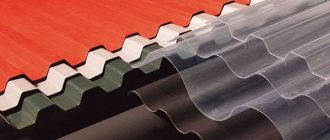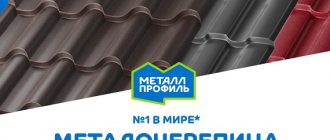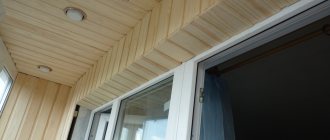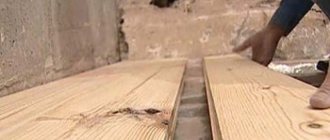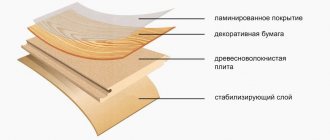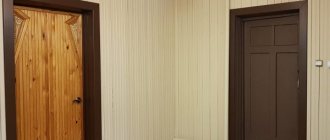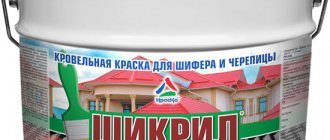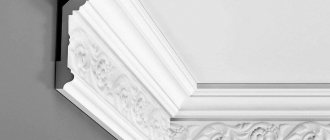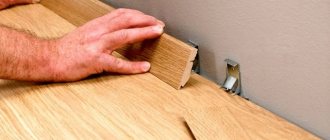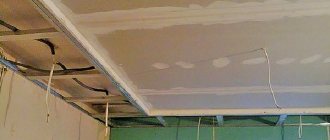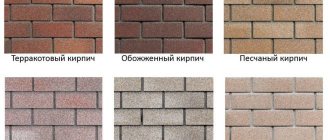Many people tend to assume that slate is exclusively sheets made of asbestos and cement, while this material is quite large in size and wavy in shape. Undoubtedly, quite recently everything was exactly like this, but this continued until polymer slate, obtained as a result of using the extrusion method in production, appeared on the market for goods and services. This building material has a large number of advantages that distinguish it from existing analogues.
Pros and cons of polymer slate
As everyone knows, any building material has some advantages and disadvantages, including polymer slate.
If we consider the strengths of plastic corrugated slate, it is worth noting the following important points:
- High level of light transmittance. It is important to consider that fiberglass and polycarbonate have the highest transparency; in these cases, the figures can reach 92%. For PVC slate this value is slightly lower and amounts to 83%. The highest figures for light transmittance are observed in transparent building materials that do not have a color tint. Translucent ones have average values, and products with a matte surface have the lowest data. As practice shows, polymer building material, which has high performance, is actively used as glazing for roofs and other buildings for which light is important.
- Resistance to mechanical damage - polymer slate has a fairly high level of strength, as a result of which it is able to withstand strong impacts and heavy loads.
- Small mass. It is several times lower than that of ordinary glass, which has the same thickness as slate. Thanks to this indicator, a roof made of polymer material is quite light, which allows it not to place a large load on the foundation.
- Easy installation process - installing polymer material is not as difficult as it might seem initially. To attach polymer slate, no special skills or experience are required. Since the weight of the polymer material is small, it is quite easy to lift it to any height during installation work.
- A wide assortment of shades - due to the fact that polymer slate contains pigments, it is possible to obtain finished products of any shade. In this case, you can get not only the traditional shade of slate, but also rich bright yellow colors.
- Flexibility: panels made of plastic can be bent if necessary, giving the structure any shape.
- High level of resistance to weather conditions, which allows you not to be afraid of strong gusts of wind, hail, rain, snowfall. In addition, the polymer material does not absorb or allow moisture to pass through.
- Slate is not subject to corrosion - rot and rust do not appear on plastic products during operation. That is why polymer products are so often used in the design of construction shops, hangars, and workshops.
- Fireproof - when exposed to fairly high temperatures, slate begins to melt, but does not undergo the combustion process.
- It is quite easy to maintain, which is facilitated by the smooth surface of the polymer material. It is worth taking into account the fact that if the polymer slate structure is made at an inclination of at least 10 degrees, then dust and dirt will not accumulate on the polymer material during operation.
- Environmentally friendly material, which is facilitated by the complete absence of substances harmful to human health.
Despite so many advantages, there are some disadvantages:
- You cannot walk on a roof made of plastic, as a result of which repairs can sometimes be quite difficult;
- during the heating process, the material is subject to expansion, and when cooled, the polymer slate takes on its previous appearance - as a result, there is a high probability that the material will be subject to deformation;
- Frequent lathing is necessary - this is primarily due to the fact that the material is very thin and flexible, and without proper lathing it will hang down;
- rather low thermal insulation characteristics, as a result of which polymer materials are not recommended for use in residential premises.
If we take into account all the existing advantages and disadvantages, it is worth noting that polymer slate is a unique building material.
Attention! If necessary, transparent plastic sheets can be used to decorate the roof.
Preparatory work
Before proceeding directly to laying slate on the roof, it is necessary to carry out some preparatory measures. These include:
- calculation of the required material;
- preparing the base for attaching slate material.
Calculation of the amount of material will depend on the type of slate that was chosen. But the essence of the calculations is to divide the total area of the roof surface to be covered by the dimensions of the slate.
If these are sheets, then by calculating the sheet area you can determine their number. In the case of the rolled variety of best man, the principle is similar.
In addition, it is advisable to take into account the load on the roofing. It can be found out based on the region parameters, which are indicated in special documentation. In addition, the future load on the slate is influenced by such parameters as the degree of roof slope and the location of the structure.
NOTE!
The minimum permissible angle of inclination of plastic slate is not less than 10 degrees.
Preparing the base for later attaching slate to it consists of preparing the so-called cellular structure, which is otherwise called lathing.
There are some requirements for this design:
- Each sheet that will be attached to the sheathing must have at least three support points.
- The frame is assembled from wood beams or boards. You can use an unsanded and unedged board, which will exceed 15 mm in thickness. As an alternative, a metal frame is used.
- Laying is carried out in a checkerboard pattern, while maintaining an intermediate distance of 200 mm.
- You can use timber with dimensions of 50x50 mm ; the intermediate distance must be selected based on the parameters of the slate sheet.
- In areas of the roof where there is any equipment, for example, a service pipe, it is necessary to install an additional contour of wooden sheathing.
- To ensure the waterproofing properties of the roof , you should resort to the use of appropriate materials.
- After all measures to prepare the roof surface have been carried out, you can begin installing the roof covering.
Surface preparation
Types of plastic slate
On sale you can find polymer PVC slate in the following colors:
- colorless, that is, transparent;
- snow-white;
- colored (the shade depends entirely on the dye used in production).
In addition, polymer slate may differ in gradation depending on light transmission:
- transparent;
- translucent or, as this option is also called, smoky;
- opaque or matte.
A roof for which plastic slate was used can look different. In this case, the cross section of the finished product plays a special role. Today, there are several types, among which we can note direct waves, resulting in an even sheet, a trapezoidal shape, and a sinusoid.
When purchasing this type of building material, it is recommended to take into account the fact that the most durable options are sheets with a wavy or trapezoidal cross-section. In addition, such options are characterized by fairly high durability and flexibility compared to their counterparts available for sale on the product market.
Coating profile
As for the profile of PVC slate roofing material, there are several types:
- Wavy leaf;
- Sinusoidal profile;
- Trapezoidal profile;
- Straight smooth leaf.
As a rule, corrugated plastic roofing materials are offered to the consumer in 7, 8 or 12 waves. In this case, the parameters of the bending ridge can be very different (73x36 mm; 82x30 mm; 51x25 mm or 28x15 mm). The thickness of corrugated roofing material varies between 0.8-1.8 mm, and the weight of one sheet varies between 1.2-3.2 kg.
Technical characteristics of polymer slate
If we consider the technical characteristics of polymer slate used for roofing, we can highlight the following points:
- the composition of the finished material includes sand, sawdust from coniferous trees, polymers, various dyes, thanks to which the finished material acquires the required shade;
- The area of each slate sheet is 1.904 square meters. m;
- usable area reaches 1.7 square meters. m;
- weight of polymer slate for each square. m can vary from 4 to 4.5 kg;
- density level – 1180 kg/m3;
- water absorption level depending on mass – maximum 0.3%;
- minimum tensile strength - 6 MPa;
- water infiltration is completely absent in this type of building material;
- high level of impact resistance, as a result of which the building material is not afraid of mechanical stress;
- fairly high resistance to existing loads;
- due to low thermal conductivity, condensation does not appear during operation;
- high sound insulation characteristics;
- heat resistance is +100 degrees;
- during operation under the influence of direct sunlight, polymer slate does not lose its original shade;
- electric charge does not accumulate during operation;
- high level of resistance to aggressive environments;
- polymer slate is not subject to corrosion;
- service life is about 50 years;
- The manufacturer provides a warranty of up to 5 years.
In addition, it is worth taking into account the fact that plastic slate rolls must be stored correctly after purchase.
Content
What is plastic slate? In appearance it is very similar to ordinary asbestos-cement. The same wave-like shape (usually) and strength. The only thing is that such slate is made from plastics of different compositions. Therefore, its surface is always glossy, shining in the sun. Moreover, it is not necessarily matte. For the most part, plastic slate has a certain amount of light transmission - sometimes up to 90-92%! That is, it can be transparent and compete with glass.
When making plastic slate, coloring pigments are introduced into the polymer composition, which are responsible for its color design. Therefore, when choosing a polymer material, you can be guided by your own taste and not limit your design imagination. The color of plastic slate can be almost any color, with varying degrees of transparency!
Application of plastic slate
As mentioned above, the peculiarity of plastic rolled slate is its low weight and the ability to transmit light. It is these main advantages that many consumers enjoy when they actively use polymer materials for the construction of the following buildings:
- greenhouses;
- greenhouses;
- winter gardens;
- verandas;
- balconies in apartment buildings;
- terraces of summer cafes;
- covered car parks;
- street shopping pavilions;
- telephone booths;
- for the arrangement of public transport stops within the city;
- canopies for swimming pools;
- terraces in residential premises;
- arrangement of patios;
- private parking lots near the house;
- sports and children's playgrounds;
- storage facilities;
- workshops;
- production hangars;
- workshops
As it becomes clear from this list, polymer slate is most often used for roofing MFAs and small production facilities. It is not recommended to use this type of slate for residential premises, since the thermal insulation characteristics are quite low. As an exception, we can consider country houses intended only for summer residence.
Compound
Plastic is a broad term that unites a whole group of synthetic polymer substances. They have different temperature resistance, strength, durability and, ultimately, different prices. Wavy and straight plastic slates are made from the following polymers:
- Polyvinyl chloride. This is an inexpensive and accessible slate, the thickness of which is 0.8-3 mm. The operating temperature of such a coating ranges from -40 to +65 degrees, transparency is up to 83%, and the service life of high-quality PVC products is at least 10-15 years. In practice, most of the models made from this polymer belong to the lowest price category and cannot boast of good quality, which is why the wavy slate becomes cloudy, turns yellow and requires replacement after 2-4 years.
Characteristics of PVC roofing covering - Polycarbonate. When visually assessed, plastic slate made of polycarbonate is no different from its analogues made of polyvinyl chloride. But during operation, the differences are obvious - it has higher impact resistance, does not fade or change color under the influence of ultraviolet rays, and maintains light transmission at 90-92% during the entire period of use. It can be used at temperatures from -60 to +100 degrees. The service life of this coating is 25-30 years, but it costs more than PVC products.
Characteristics of polycarbonate roofing - Fiberglass. Fiberglass is a combined material that consists of fiberglass and polyester resins. Fiberglass plays the role of a kind of reinforcing base, enhancing impact resistance, as well as extending the service life of fiberglass slates. This material has light transmittance of up to 92%, sheet thickness of 0.8-2 mm and operating temperature of up to 120 degrees. Fiberglass models last up to 25-30 years without changing color or becoming cloudy.
Characteristics of fiberglass roofing
Important! A significant disadvantage of traditional asbestos-cement slate is the environmental unsafety of the composition. The danger is posed by asbestos dust, which, penetrating into the human respiratory tract, damages the lungs and mucous membranes. Fiberglass, polyvinyl chloride, and polycarbonate have proven safety for health and the environment, which has been repeatedly tested by many research laboratories.
Advantages
- Transmits light well.
- Small mass.
- The material is quite durable and can withstand various loads.
- Easy installation.
- Large selection of colors.
- Flexibility.
- Fire safety.
- Resistant to all weather conditions.
- Minimum care requirements.
- Resistant to corrosion and chemical influences.
- Environmentally friendly.
Flaws
- During installation, more frequent lathing is required.
- Unable to withstand heavy weight.
- Poor thermal insulation, which makes it impossible to use it for the construction of residential premises.
- Expansion when heated.
Features of installation of plastic slate
When purchasing plastic slate for a roof, you should immediately take into account the fact that the manufacturer includes with each set the appropriate instructions for carrying out installation work, as well as recommendations for installing the sheathing. If the manufacturer misses the point regarding the pitch of the bar, then the distance should vary from 35 cm to 45 cm. Thanks to such a dense lathing, it is possible to obtain a coating with optimal functions.
It is recommended to install slate from below, starting from the drainpipe, gradually moving to that part of the roof from where the wind constantly blows. The laying must be overlapped. If you choose corrugated polymer slate, you will need to additionally install strips to ensure rigidity; they will need to be inserted into odd waves.
Self-tapping screws are used as fastening. It is best to use about 16 self-tapping screws for each sheet, and it is recommended to indent 5 cm from the edge. To ensure that the material is not damaged during the drilling process, special spacers should be used. If necessary, you can eliminate the possibility of moisture getting under the roof; for this, it is recommended to use special seals on the holes made of rubber.
Advice! Before you start arranging the sheathing, it is recommended to treat the wooden blocks with special compounds, thanks to which you can prevent the appearance of fungus and mold.
Release forms
Plastic slate is considered a universal material used for the construction of greenhouses, the construction of roofs of gazebos and terraces, the installation of canopies for indoor pools, as well as in many other areas. Manufacturers produce products with the following characteristics:
- Release forms. PVC roofing coatings are produced in the form of sheets and rolls. The sheets have a standard size of 2000x90 mm. The length of the rolls varies between 10-30 m; they are used if the surface to be covered has non-standard dimensions in order to reduce the amount of waste when cutting the material.
Plastic slate in the form of rolls - Color . Plastic slate sheets are available in a wide range of colors. Manufacturers usually include red, yellow, blue, and green shades in their range. Colorless material is often used to cover greenhouses.
- Transparency . Construction markets offer transparent, translucent or opaque plastic slate. Translucent products have a light transmittance of 75-80%, so the silhouette is poorly visible through it. Transparent models with light transmission of about 90% are excellent for equipping greenhouses or conservatories.
- Profile. Manufacturers produce wavy and straight slates made of plastic. Wavy models are used for the construction of single-pitched roofs of gazebos, canopies or terraces, and straight ones are used for the construction of roofing structures in the form of tents and domes.
Monolithic plastic slate sheets
Experienced craftsmen claim that even a person without experience can handle the installation of plastic slate covering. Sheets of this material are easily cut with a sharp knife and then fixed to the frame using a screwdriver. But do not forget that this type of coating has increased flexibility, so you cannot save on the sheathing.
Service life
As practice and reviews show, polymer slate can achieve a service life of 50 years. It is important to take into account the fact that this indicator also depends on how to care for the building material during operation and carry out installation work. Thus, if you install the polymer material according to the instructions supplied by the manufacturer and promptly remove snow in winter, thereby preventing the material from sagging, then the service life can not only reach 50 years, but also exceed this figure.
What does the modern market offer?
Among the brands, the most popular are Salux profiled sheets, made in Germany. Such transparent slate is so durable that it is not only used to cover roofs, but even to build light walls. At the same time, light weight is maintained, which is convenient for installation.
Its properties are very similar to the previous transparent Tuftex slate. But there is a significant difference between the materials of these manufacturers: Tuftex slate is made of vinyl, while Salux slate is made of polyvinyl chloride.
But Salux W sheets are intended for the roofs of greenhouses and gazebos. They are also used to enclose skylights on farms. The quality of these sheets is at the highest level - for 10 years, even the thinnest of them, up to one millimeter, do not lose either strength or transparency.
No less popular on the Russian market are the products of such companies as the Italian Eliplast and the domestic Eterus. To install these materials, it is enough to use the same fasteners as for corrugated steel sheets.
French PVC slate from Ondex is also not inferior in quality. Transparent profiled sheets of this brand are durable: they can withstand any snow and hail, are resistant to chemical attack, never become cloudy and boast high fire resistance.
All sheets of this brand are factory produced by extrusion. Moreover, this plastic is also additionally stretched in the transverse and longitudinal directions to give it increased strength - this method is called bidirectional orientation.
If we talk about existing brands of plexiglass, we note that the differences in the main characteristics are insignificant and relate only to additives, dyes, equipment and packaging.
Fiberglass roofing material
When constructing roofs for sheds, verandas and greenhouses, fiberglass slate is often used.
It is a combined material. The basis of fiberglass slate is fiberglass treated with various polymers.
This type of slate has high strength and resistance to ultraviolet rays. Fiberglass slate is available in different colors.
This slate has the following advantages:
- This material has the same strength as steel, but is four times lighter;
- The thermal conductivity of the material is three times better than that of glass;
- Does not rust;
- Doesn't rot.
Fiberglass slates, just like asbestos slates, are secured to metal or wood sheathing with self-tapping screws. Seals are also used in conjunction with self-tapping screws.
Advantages
- Transmits light well . Fiberglass and polycarbonate have the highest degree of transparency, PVC is slightly worse. Good permeability applies only to transparent slate, to which no colored component has been added. This feature allows it to be used for glazing structures that require sunlight. It is also possible to make the entire roof or part of it from panels, providing the roof with skylights.
- Small mass. Having the same thickness as the traditional roofing option, the weight differs by about 3 times , making the roof light. This feature allows you to build a building on a lightweight foundation and reduce the thickness of the walls used.
- The material is quite durable and can withstand various loads.
- Easy installation. Laying the roof is not difficult and does not require special knowledge . Also, due to its light weight, anyone can lift it, regardless of physical fitness.
- Large selection of colors. This allows you to make a roof that will be in harmony with the rest of the building, because traditional slate often does not look very acceptable on the erected structure.
- Flexibility. Flexible slate allows you to form a roof of non-standard shape.
- Fire safety. When exposed to high temperatures, plastic begins to melt, which means it will not contribute to the spread of fire.
- Resistant to all weather conditions. Plastic can withstand any weather: wind, solar radiation, extreme temperatures, rain and snowfall. It does not absorb moisture, and therefore will not swell from it.
- Minimum care requirements. Plastic slate is very smooth, and a roof with a minimal slope angle will not accumulate dust and dirt . Even if severe contamination appears, getting rid of it with a stream from a hose will not cause any difficulties. Dust does not penetrate inside the panel, so the ability to transmit sunlight is not lost.
- Resistant to corrosion and chemical influences. It is not subject to rotting or corrosion. Any reagent will also not be able to cause harm. Industrial emissions and pollution from various vehicles do not reduce its performance properties.
- Environmental friendliness . Unlike its traditional asbestos-cement counterpart, which contains asbestos, the material does not contain substances hazardous to humans and the environment.
Flaws
- During installation, more frequent lathing is required. Due to its small thickness and flexibility, with a large lathing step it will sag downwards.
- Unable to withstand heavy weight. This complicates the installation process, since it will require the installation of walkways.
- Poor thermal insulation , which does not make it possible to use it for the construction of residential premises.
- Expansion when heated . Plastic tends to expand when heated. To avoid deformation, it is necessary to make the mounting holes a few millimeters larger.
